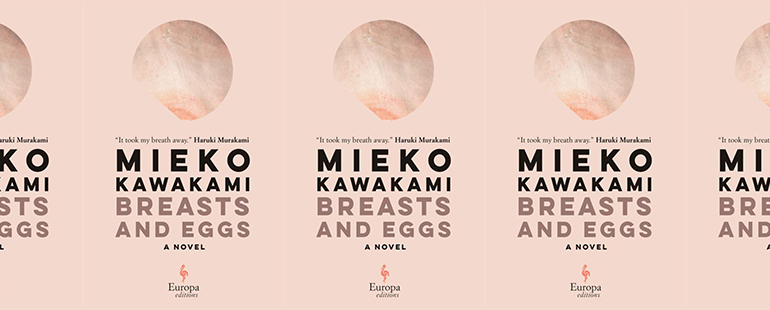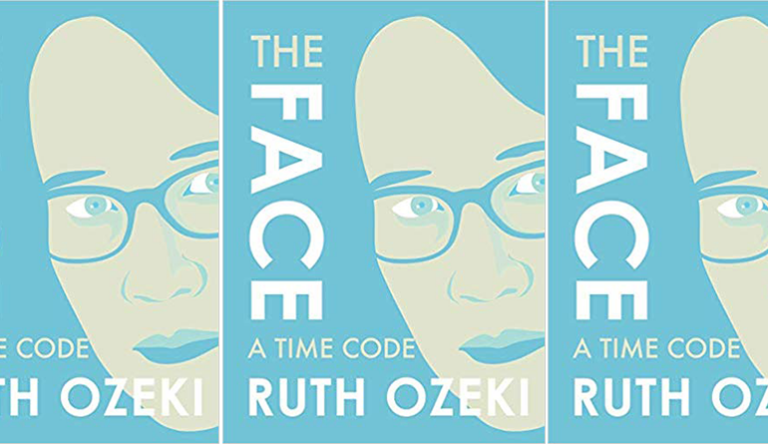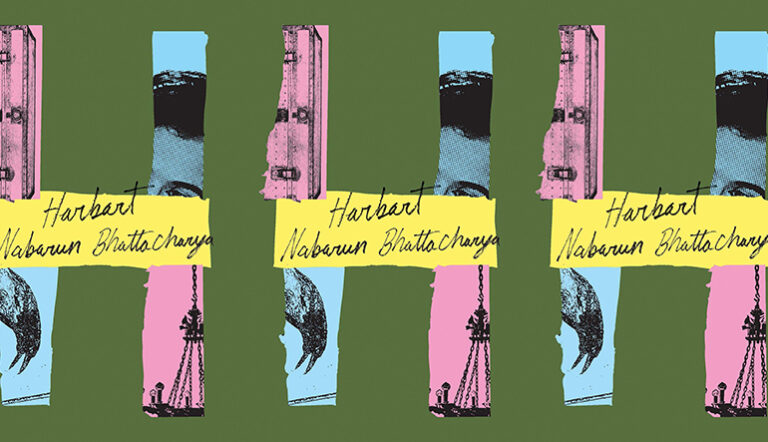Womanhood in Breasts and Eggs

Mieko Kawakami has been a powerhouse literary figure in Japan since her debut novel わたくし率 イン 歯一、または世界 (Watakushi ritsuin hā, mata wa sekai), which has yet to be translated into English, won her the 2007 Tsubouchi Shoyo Prize for Young Emerging Writers. Her novella, 乳と卵 (Chichi to ran), won her the prestigious Akutagawa Literary Prize the following year, and she has continued to garner awards and praise for her work in multiple genres. Kawakami’s work has been trickling into the English-speaking world via translations by Hitomi Yoshio, which have appeared in Granta, Pleiades, and Words Without Borders, and more recently, her novels have been translated in their entirety—including Chichi to ran, which came out in an expanded version via translation by Sam Bett and David Boyd as Breasts and Eggs this April. After years of success in Japan, Kawakami’s stunning blend of humor, sharp commentary, and evocative imagery is making waves throughout English-reading audiences.
It would be easy to boil the themes of Breasts and Eggs down to the two key aspects of womanhood imposed on women in Japan—sexual attractiveness and motherhood. In an interview with Motoko Rich for the New York Times, Kawakami touches on the expectations placed on women to be desirable and to have their desire shaped by convention and gender expectation. “It’s a humiliation among women not to be desired by men,” she says. “That’s a very strong code in Japanese society.” Kawakami’s power, particularly in Breasts and Eggs, is to place this code in the spotlight and refuse to play by its rules.
Breasts and Eggs centers on Natsuko Natsume, a writer who is struggling with composing her women writers and acquaintances, and even the memories of her deceased mother and grandmother shape the flow of the narrative. While there are a handful of men in the story, the bulk of the novel focuses solely on interactions between women. The book’s first section revolves around Natsuko’s older sister, Makiko, and Makiko’s teenaged daughter, Midoriko, as they visit Natsuko in Tokyo from Osaka. Makiko works as a hostess at a bar and has become obsessed with the idea of getting breast implants. Midoriko is horrified by her mother’s fixation and, through snippets of Midoriko’s journal entries, readers find that Midoriko is struggling with the idea of menstruation and motherhood. In one journal entry, she writes:
It feels like I’m trapped inside my body. It decides when I get hungry, and when I’ll get my period. From birth to death, you have to keep eating and making money just to stay alive . . . Life is hard enough with just one body. Why would anyone ever want to make another one? I can’t even imagine why anyone would bother, but people think it’s the best thing ever. Do they, though? I mean, have they ever really thought about it? When I’m alone and thinking about this stuff, it makes me so sad. At least for me, I know it’s not the right thing.
At the beginning of the novel, Midoriko and Makiko are not speaking—Midoriko literally does not speak, instead using a notepad she carries around with her to ask questions and respond to others. Her journal is the only place where she is able to work through the things that weigh on her: the social expectations of conforming to certain beauty standards, the expectation of excitement that is supposed to come from getting one’s period and reaching sexual maturity, and the expectation that she should already be looking forward to marriage and motherhood. Although Midoriko mentions other girls at her school who do align with these expectations, she finds most of them stifling and even terrifying. Midoriko’s journal entries are just one avenue through which Kawakami interrogates received gender expectations, unambiguously articulating, through Midoriko, a stance that runs counter to common attitudes. Though Natsuko is the main character, Kawakami expertly weaves a complex array of experiences into her narrative, giving readers a spectrum of philosophies on what it is to be a woman, what women are allowed want, and what the appropriate methods are for women to achieve these designated desires.
Kawakami addresses these topics throughout the second part of the novel as Natsuko realizes that she wants to become a mother. Her desire for motherhood is seemingly incompatible with the way others view her. As someone who does not want to be partnered and who does not particularly enjoy sex, Natsuko begins looking into options for artificial insemination, which she keeps secret from most of her family and friends. Her silence ends up being prudent: when she begins opening up about her decision, she quickly faces conflicting opinions held by those around her—those who can’t understand why she would follow this particular path to have a child, children who themselves have been brought into the world by artificial insemination and are working through the identity struggles that accompany their birth stories, and those who simply believe it is irresponsible for Natsuko to be a single mother. In most cases, Natsuko’s desire to be a mother is negated simply because she wishes to follow an unconventional path.
Readers stay close to Natsuko and see her as she struggles with her own desire to be a mother and the external barriers—either ideological or logistical—that stand in the way of her achieving what she wants. Beneath the conversations that Natsuko has with other women, however, there is always a sense of understanding and even acceptance, though the acceptance is rarely given to her in return. Even if Natsuko disagrees when another character pontificates at her, she thinks through their words and understands where they are coming from. For instance, when Makiko fixates on her desire for breast implants to the degree that her relationship with her daughter, Midoriko, is strained, Natsuko says, “But who was I to judge? I’d moved to Tokyo so I could be alone, and I was single in the most literal way possible. I wasn’t a mother. I had no right to tell her how to raise her child.”
This question of who is to judge echoes throughout the novel, even in situations that initially seem to be invitations for readers to judge the characters. Makiko’s breast implants, which could easily be played as a cheap shot against women of a certain age who cling to their youth or sexual desirability, are presented as understandable rather than laughable. While Natsuko has her opinion on the matter, situations like these are always presented in larger societal contexts. Because of their family history, Makiko needed to drop out of school and work in order to support the family when she was younger, which set the course for the majority of her working life. In the context of Makiko’s precarious financial situation and her desire to provide for her daughter, breast implants become something that could potentially improve her sexual desirability (which is useful for her hostess work) but also could simply make her feel better, even if no one else thinks they are a good idea.
Desire for something, whether for larger breasts or for a child, is often complex and irreducible. Even after multiple characters press her on why she wants a child, Natsuko herself eventually simply responds that she just wants a child, wants to know who they will be. She cannot offer an explanation other than that she wants what she wants and that alone should be enough.
By presenting a multitude of experiences, Breasts and Eggs depicts the shifting understanding of gender in Japan. In the essay “Women’s Work at Home and in the Workplace” in Beyond the Gender Gap in Japan, Gill Steel points out that though gender roles remain rigid, there are more women seeking out a path beyond convention. Steel writes, “Women are now far more likely to graduate from a four-year university than they used to be; they have entered the labor force in remarkable numbers; they marry later or, increasingly, not at all; and they have fewer children.” Yet, Steel does note that women in Japan still face a number of barriers, including gender expectations in both corporate and domestic spaces. In an interview with the Japanese fashion magazine Precious, Kawakami echoes a similar sentiment. She says, “The usual getting married and giving birth are no longer life events. There is a diversification in women’s lifestyles and Japan is changing dramatically, but the laws about things like the declining birth rate, for example, are still made by older men” (translation by me).
In other interviews with various Japanese publications, Kawakami has expressed her desire to write about the feminist topics that appear in her work as a way to bring them out in the open and point out the gap between what women want for themselves and what society will allow them to achieve. If there are things that are amiss within society, then it is the duty of a writer to point out these issues in order for them to change. Breasts and Eggs addresses the multifaceted nature of what it means to move through the world as a woman, which means presenting womanhood in a variety of ways, ages, and life experiences.


